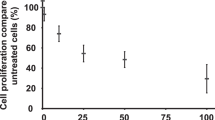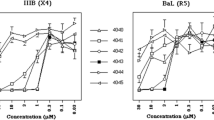Abstract
Thiolated pyrimidine derivatives have been synthetized and their antiretroviral effect against human immunodeficiency virus type 1 (HIV-1IIIB) and HIV-1 chimeric pseudovirions have been quantitatively determined in cell-based viral infectivity assays including syncytium inhibition assay as well as a single-cycle viral infection assay on HeLaCD4-LTR/ß-gal cells. Pseudotype virions prepared bearing HIV-1 envelope preference for CCR5 coreceptor, CXCR4 coreceptor or for both, respectively, with a HIV-1 core containing luciferase reporter gene were able to infect susceptible cells but are replication defective so unable to replicate in the cells . Data indicate that thiolated pyrimidine derivatives inhibited effectively virally induced cell fusion in vitro as well as infectivity of primary HIV-1IIIB strain and HIV-1 pseudovirions using chemokine receptors CCR5 or CXCR4 or both for virus entry a dose dependent manner. Inhibition was selective, depended on the pseudovirus coreceptor preference. Our results suggest that some of these sulfur containing pyrimidines interact with redoxactive -SH groups required for successful HIV entry, including a redox active disulfide in the CD4 molecule as well as -SH groups in HIV viral envelope gp120. This mode of action is unique representing a new class of potential HIV entry inhibitors.
Similar content being viewed by others
References
Kaplan JE, Hanson D, Dworkin MS, Frederick T, Bertolli J, Lindegren ML, Holmberg S, Jones JL (2000) Epidemiology of human immunodeficiency virus-associated opportunistic infectiopns in the United States in the era of highly active antiretroviral therapy. Clin Infect Dis 30:S5–S14
Baeten JM, Donnell D, Ndase P, Mugo NR, Campbell JD, Wangisi J, Tappero JW, Bukusi EA, Cohen CR, Katabira E et al (2012) Antiretroviral prophylaxis for HIV prevention in heterosexual men and women. N Engl J Med 367:399–410
Kanizsai S, Ghidán Á, Ujhelyi E, Bánhegyi D, Nagy K (2001) Monitoring of drug resistance in therapy-naive HIV infected patients and detection of African HIV subtypes in Hungary. Acta Microbiol Immunol Hung 57(1):55–68
Triant VA, Lee H, Hadigan C, Grinspoon SK (2007) Increased acute myocardial infarction rates and cardiovascular risk factors among patients with human immundiodeficiency virus disease. J Clin Endocrinol Metab 92:2506–25012
Monforte AD, Abrams D, Pradier C, Weber R, Reiss P, Bonnet F, Kirk O, Law M, de Witt S, Friis-Moller N et al (2008) HIV-induced immunodeficiency and mortality from AIDS-defining and non-AIDS-defining malihgnancies. AIDS 22:2143–2153
Neuhaus J, Jacobs DR, Baker JV, Calmy A, Duprez D, la Rosa A, Kuller LH, Pett SL, Ristola M, Ross MJ (2010) J Infect Dis 201:1788–1795
Didigu C, Doms RW (2014) Gene therapy targeting HIV entry. Viruses 6:1395–1409
Deng H, Liu R, Ellmeier W, Choe S, Unutmaz D, Burkhart M, di Marzio P, Marmon S, Sutton RE, Hill CM et al (1996) Identification of major co-receptor for primary isolates of HIV-1. Nature 381:661–666
Kemény B, Nagy K, Horváth A (2000) CCR5 and SDF1 gene polymorphism in HIV-infected and healthy individuals in Hungary. Hung Venerol Arch IV(2–3):89–92
Ryser HJ, Levy E, Mandel R, DiSciullo GJ (1994) Inhibition of human immunodeficiency virus infection by agents that interfere with thiol-disulfide interchange upon virus-receptor interaction. Proc Natl Acad Sci U S A 91:4559–4563
Barbouche R, Miquelist R, Jones IM, Fenouillet E (2003) Protein-disulphide isomerase-mediated reduction of two disulfide binds of HIV envelope glycoprotein 120 occurs poet-CXCR4 binding and is required for fusion. J Biol Chem 278(5):3131–3136
Beck Z, Kis A, Berenyi E, Kovacs P, Fesüs L, Aradi J (2009) 4-Thio-uridylate (UD29) interferes with the function of protein –SH and inhibits HIV replication in vitro. Pharmacol Rep 61:343–347
Campbell S, Crowe SM, Mak J (2001) Lipid refats and HIV-1: from viral entry to assembly of progeny virions. J Clin Virol 22:217–227
Kanizsai S, Ongrádi J, Aradi J, Nagy K (2014) Thiolated pyrimidine derivatives may interfere thiol groups concentrated at lipid rafts of HIV-infected cells. Acta Microbiol Immunol Hung 61(4):447–458
Kanizsai S, Ghidán A, Ongrádi J, Nagy K (2012) Antiretroviral effect of 4-thio-uridylate against human immunodeficiency virus type. Acta Microbiol Immunol Hung 59(4):499–510
Nagy K (2007) HIV pseudovirions assay for coreceptor selection and entry fitness. Proc. HIV correlates (Ed:Fust G) p12., Budapest
Matthias LJ, Yam PT, Jiang XM, Vandegraaff N, Li P, Poumbourios P, Donoghue N, Hogg PJ (2002) Disulfide exchange in domain 2 of CD4 is required for entry of HIV-1. Nat Immunol 3:727–733
Horváth A, Tőkés S, Hartman T, Watson K, Turpin JA, Buckheit RW Jr, Sebestyén Z, Szöllősi J, Benkő I, Bardos TJ, Dunn J, Fésűs L, Tóth FD, Aradi J (2005) Potent inhibition of HIV-1 entry by Suligovir (s4dU)3. Virology 334:214–223
Jármy G, Henekelein M, Weissbrich B, Jassoy C, Rethwilm A (2001) Phenotypic analysis of the sensitivity of HIV-1 to inhibitors of the reverse transcriptase, protease and integrase using a self-inactivating virus vector system. J Med Virol 64(3):223–231
Nagy K, Young M, Baboonian C, Merson J, Whittle P, Oroszlan S (1994) Antiviral activity of human immunodeficiency virus type 1 protease inhibitors in a single cycle of infection: Evidence for a role of protease in the early phase. J Virol 68:757–765
Nagy K, Clapham P, Cheingsong-Popov R, Weiss RA (1983) Human-T-cell leukemia virus type I: induction of syncytia and inhibition by patients’ sera. Int J Cancer 32:321–328
Clapham P, Nagy K, Cheingsong-Popov R, Exley M, Weiss RA (1983) Productive infection and cell-free transmission of human T-cell leukemia virus in a non-lymphoid cell line. Science 222:1125–1127
Didigu C, Doms RW (2012) Novel approaches to inhibit HIV entry. Viruses 4:309–424
Dumas F, Preira P, Salome L (2014) Membrane organization of virus and target cell plays a role in HIV entry. Biochimie 107:22–27
Zarr M, Siliciano R (2015) Stoichiometric parameters of HIV-1 entry. Virology 474:1–9
Acknowledgments
This work was supported by OTKA 81367 Grant from the National Science Foundation of Hungary
Author information
Authors and Affiliations
Corresponding author
Ethics declarations
Conflict of Interest
The authors declare there is no conflict of interest in this work.
Rights and permissions
About this article
Cite this article
Kanizsai, S., Ongrádi, J., Aradi, J. et al. New Approach for Inhibition of HIV Entry: Modifying CD4 Binding Sites by Thiolated Pyrimidine Derivatives. Pathol. Oncol. Res. 22, 617–623 (2016). https://doi.org/10.1007/s12253-016-0044-y
Received:
Accepted:
Published:
Issue Date:
DOI: https://doi.org/10.1007/s12253-016-0044-y




